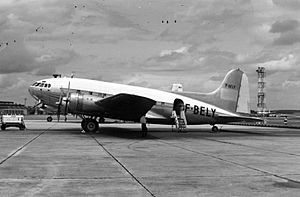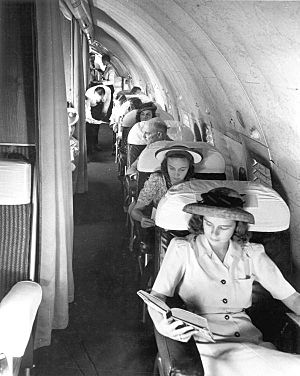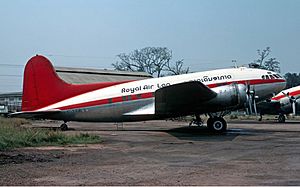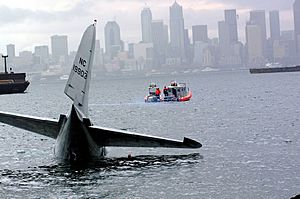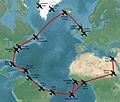Boeing 307 facts for kids
Quick facts for kids Boeing 307 / C-75 |
|
|---|---|
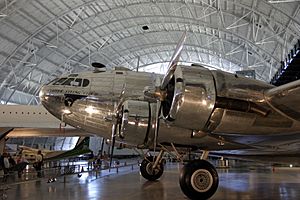 |
|
| A Boeing 307 at the Steven F. Udvar-Hazy Center | |
| Role | Airliner |
| Manufacturer | Boeing |
| First flight | 31 December 1938 |
| Introduction | 8 July 1940 |
| Retired | 1975 |
| Status | Retired |
| Primary users | TWA Pan Am United States Army Air Forces |
| Number built | 10 |
| Unit cost | $315,000 (in 1937) |
| Developed from | Boeing B-17 Flying Fortress |
The Boeing Model 307 Stratoliner was a special airplane built by Boeing. It was the first airliner to have a pressurized cabin. This meant the Boeing 307 could fly very high, at about 20,000 ft (6,000 m). Flying this high allowed it to go above most bad weather. Inside the plane, it felt like you were only at 8,000 ft (2,440 m), even when the plane was much higher.
The Model 307 could carry five crew members and 33 passengers. Its cabin was almost 12 ft (3.6 m) wide, which was quite big for its time. It was also the first land-based plane to have a flight engineer as part of its crew.
Contents
Building the Stratoliner
In 1935, Boeing started designing a new four-engine airliner. This plane was based on the famous Boeing B-17 Flying Fortress bomber. It was called the Model 307. It used the same wings, tail, rudder, landing gear, and engines as the B-17C.
However, the main body of the plane was different. It was shaped like a perfect circle, about 138 in (350 cm) across. This round shape was important because it allowed the cabin to be pressurized.
The first company to order the plane was Pan American Airways in 1937. They ordered more planes later. Another airline, Transcontinental & Western Air (TWA), ordered five of these new aircraft. Boeing then began building the planes.
The C-75 Military Version
When the United States joined World War II in December 1941, flying became very important for the government and military. Long-distance flights were needed for officers and supplies. Planes like Pan Am's flying boats and TWA's five Boeing 307s were used for this.
To fly further, extra fuel tanks were added to the planes. These military versions of the Boeing 307 were called C-75s. Before the war stopped production, 10 Stratoliners had been built for airlines. TWA flew their planes between New York and Los Angeles for 18 months. Then, the U.S. Army bought their planes.
TWA changed their 307s into C-75s in January 1942. These C-75s were the only American planes that could cross the Atlantic Ocean with cargo. This was true until the Douglas C-54 Skymaster was made in November 1942.
For military use, the C-75s had their special pressurization equipment removed. This made the plane lighter. Some seats were also taken out, and other changes were made. Five large fuel tanks, each holding 212.5 U.S.gal (804 L), were added. The landing gear was made stronger, and the plane could carry more weight when taking off. The outside of the planes was painted olive drab, a military green color.
History of the Stratoliner
The very first Boeing 307 Stratoliner flew on December 31, 1938, from Boeing Field in Seattle. Sadly, this first plane crashed on March 18, 1939, while the airline KLM was testing it.
The first delivery of a Stratoliner was to Howard Hughes. He bought one Boeing 307 because he wanted to fly around the world faster than ever before. Hughes' plane had extra fuel tanks for this long journey. It was ready to go, but then Nazi Germany invaded Poland on September 1, 1939. Because of the war, Howard Hughes did not make his flight. This 307 later had its extra fuel tanks removed and more powerful engines added. It was supposed to be a fancy "flying penthouse" for Hughes, but he didn't use it much. It was eventually sold.
Pan Am started receiving its Boeing 307s in March 1940. TWA got its first 307 in April. TWA used its 307s to fly from Los Angeles to New York. Pan Am's planes flew from Miami to Latin America.
In total, ten 307s were made. Three went to Pan Am, named Clipper Flying Cloud, Clipper Comet, and Clipper Rainbow. Five went to TWA, named Comanche, Cherokee, Zuni, Navajo, and Apache. One went to Howard Hughes. The very first 307 built was the one that crashed.
After the United States joined World War II, Pan Am continued to fly its planes to Central and South America. However, the Army Air Force was now in charge of these flights. TWA's Boeing 307s were sold to the U.S. government. They were called Boeing C-75 and were used by the United States Army Air Forces.
The U.S. Army gave the five C-75s back to TWA in 1944. TWA sent them back to Boeing to be rebuilt. Boeing replaced the wings and put in more powerful engines. The electrical systems were updated with parts from the Boeing B-29 Superfortress. After these changes, the 307 could carry 38 passengers. TWA later switched to the Lockheed Constellation, but the 307s were used until April 1951. TWA then sold its Stratoliners to a French airline called Aigle Azur.
C-75 Military Routes
The C-75 military planes flew two main routes during the war. One route was from Washington, D.C. to Cairo, Egypt. The other was from New York to Scotland. Sometimes, they flew from Gander, Newfoundland to Prestwick, Scotland. They also flew between Natal, Brazil and Accra, Ghana. After July 1942, they could stop to refuel at Ascension Island.
Different Types of Boeing 307
- 307: This version had Wright Cyclone GR-1820-G102 engines and a crew of five.
- 307B: This version had Wright Cyclone GR-1820-G105A engines and a crew of seven.
- C-75: These were Boeing 307s that were used by the U.S. military during World War II.
Who Used the Boeing 307?
Civilian Users
 France Aigle Azur
France Aigle Azur Laos Royal Air Laos
Laos Royal Air Laos United States Howard Hughes (bought one plane)
United States Howard Hughes (bought one plane) United States Pan Am (had three planes)
United States Pan Am (had three planes) United States TWA (had five planes)
United States TWA (had five planes)
Military Users
 Haiti Haitian Air Force
Haiti Haitian Air Force United States United States Army Air Forces
United States United States Army Air Forces
Boeing 307s Still Around
The only complete Boeing 307 Stratoliner that still exists is at the Smithsonian Museum's Steven F. Udvar-Hazy Center. On March 28, 2002, this plane was badly damaged when it had to land in Elliott Bay in Seattle, Washington. This was its last flight before it went to the Smithsonian for display.
The main part of Howard Hughes' 307 also still exists, but it has been turned into a house boat.
Related pages
- Aircraft related to this one
Images for kids
-
Boeing C-75 ICD primary wartime transatlantic routes after July 1942, when the airfield as Ascension Island shortened the South Atlantic crossing. Bluie Two and Eight were added in 1942 as diversionary airfields in case excessive headwinds were encountered in the North Atlantic. When conditions allowed it, usually on summer eastbound crossings, direct flights were sometimes made between Gander and Prestwick.
-
Restored ex-Pan Am Stratoliner NC19903 displayed in the Steven F. Udvar-Hazy Center
See also
 In Spanish: Boeing 307 para niños
In Spanish: Boeing 307 para niños


